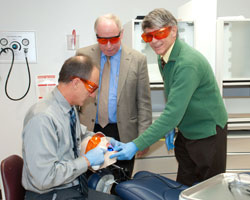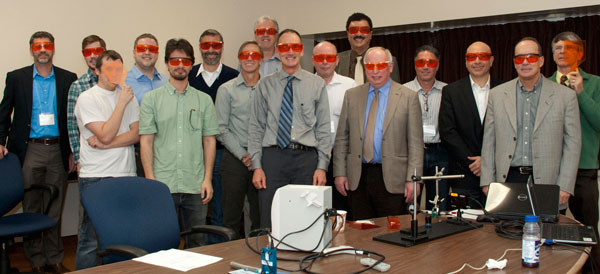 (From left) Drs. Richard Price (sitting), Dalhousie University; David Watts, University of Manchester; Frederick Rueggeberg, Georgia Health Sciences University
(From left) Drs. Richard Price (sitting), Dalhousie University; David Watts, University of Manchester; Frederick Rueggeberg, Georgia Health Sciences University
Experts in dental restorative materials from North America and Europe convened at Dalhousie University in Halifax to discuss light curing of resin and its potential contribution to the worldwide problem of poor patient outcomes involving resin-based restorations. The first annual Symposium on Light Sources in Dentistry, held October 10-12, was organized by Dr. Richard Price of Dalhousie University’s faculty of dentistry.
Advances in dental restorative materials and light curing adhesive technology have changed the way dentists use light to cure resin-based restorations. Powerful light-emitting diodes (LED) have replaced quartz-tungsten halogen lights as the popular choice for clinical practice—some lights are 20 times more powerful than those on the market 15 years ago and some claim curing times of less than 3 seconds. However, despite these advances, many resin-based restorations fail prematurely and eventually need to be replaced, resulting in potentially more tooth decay, larger restorations, endodontic treatment, or other costly procedures.
According to a literature review presented at the symposium, a high number of dental curing lights used in dental offices worldwide perform well below acceptable levels. Participants discussed the intricate process of light curing and recent evidence that could be used to improve patient outcomes, including the development of experimental resins with potential for enhanced clinical performance, real-time monitoring of the polymerization reaction, and evaluation of a curing light’s ability to cure resins through beam profiling and microhardness mapping. Orange ‘blue-blocker’ eyewear was presented as an effective safety measure for protecting dental professionals from the dangers of acute and chronic exposure to the intense blue curing light.
 (From left) S. Armstrong, T. Price, B. Sullivan, T. Haenel, I. Kostylev, B. Möginger, J. Stansbury, D. Labrie, R. Price, A. Shortall, O. El-Mowafy, D. Watts, J. Ferracane, M. Vargas, K. Vandewalle, F. Rueggeberg
(From left) S. Armstrong, T. Price, B. Sullivan, T. Haenel, I. Kostylev, B. Möginger, J. Stansbury, D. Labrie, R. Price, A. Shortall, O. El-Mowafy, D. Watts, J. Ferracane, M. Vargas, K. Vandewalle, F. Rueggeberg
A key outcome of the symposium, which was funded by the Canadian Institutes of Health Research Dissemination Events program, was the development of an action plan for improving patient outcomes after resin-based restorations. It calls for the development of guidelines for effective light curing, increased awareness of issues associated with dental resin photopolymerization, instructions for dental professionals in the safe and effective use of a curing light, and the development of restorative materials that are less sensitive to technique than currently available resin composites.
Look for further details on the Halifax symposium, along with educational resources for dentists on light curing, in future JCDA communications.
